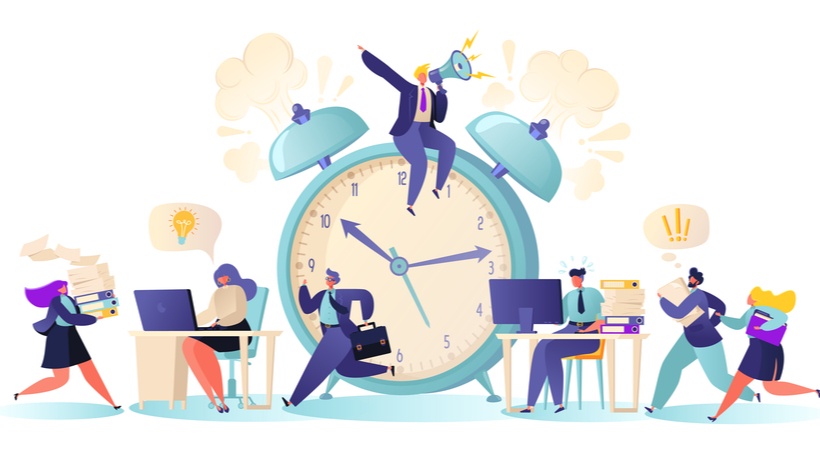How Time Tracking Apps Improve Workplace Productivity
The best employee time tracking apps aren’t just for calculating billable hours and mapping out project milestones. They help your team improve workplace performance and productivity. Everyone has the opportunity to identify pain points and set realistic goals. For example, they need to wrap up this task by the end of the week or delegate tasks to deliver on time. You can even implement hours tracker apps to build a stronger team dynamic and foster remote collaboration. Here are some insider secrets to help you maximize your most valuable asset (aka in-house talent).
7 Tips To Use Time Keeping Software For On-The-Job Productivity
1. Host A Kick-Off Event To Get Employee Buy-In
Using the software might be mandatory, but you still need staffer buy-in. Host an event before launching the time keeping app so that employees know what’s in store. Explain why you chose the tool and how it will help them be more productive. The key is to answer one important question: what’s in it for them? How does it make their life easier and help them maximize their workday? This also gives them the chance to ask questions about the software and roll-out process. When is the big day? What’s expected of them? For instance, your HR team may have to master the tool beforehand so that they can teach other departments.
2. Evaluate Daily Performance
How much time is spent on each work task in every department? Did employees take an hour to complete an activity that’s normally 20 minutes? How can you help them boost workplace efficiency? Take a closer look at daily performance overviews to look for areas of improvement. You should also pay attention to activities that take less time than planned because this is a good indication of strong suits. For instance, most of your staffers need two hours to update payroll logs and bill clients. However, one employee did the job in under 30 minutes. They might be the best person for that task moving forward.
3. Use Visual Aids To Identify Patterns
Many hours tracker tools feature visual aids to help you spot trends. For instance, graphs or charts reveal that certain work tasks are digging into your profit margin. Your employees work more hours than expected on a client project, and it’s too late to adjust the cost estimate. Is there a way to speed up these activities without sacrificing quality? For example, you might be offering staffers additional resources (i.e., software or assets). Or encourage them to host daily meetings to boost collaboration.
4. Create A Project Calendar
A project calendar gives employees a high-level overview of upcoming tasks they need to keep an eye on as well as activities that coworkers have already completed so that they know when to step in. For example, another member of the team just finished the research. So, they’re up to bat when it comes to compiling all the info and drafting the first web copy. This allows them to schedule the necessary tasks and then track progress as they check each item of their to-do list.
5. Ask Employees To Include Brief Task Descriptions
Top time tracking apps allow you to add descriptions for each activity. So, encourage employees to include a brief blurb about the task and what it involves. For example, the research task I mentioned above has multiple steps, from finding credible content to identify key takeaways. This enables you to dive into every task and improve workplace productivity. Maybe they can cut out steps that overlap with other activities.
6. Launch Team Dashboards
Dashboards give employees the chance to see what team members are working on and get extra motivation. For instance, their coworker has already completed most of the preceding tasks. So, they need to clear their schedule for next week to wrap up the rest of the project or they can help them by handling some side tasks to expedite the process. In short, team dashboards keep all the activities centralized. That said, you should give groups the opportunity to customize their page layout so that they can pin essential tasks and set reminders for upcoming due dates or milestones.
7. Highlight Top Activities
Which tasks take up the most time and why? Many time tracking apps feature "top activity" sections that allow you to find resource drainers. In other words, tasks that lead to higher payroll expenses or potentially cause delays. Then again, some top activities might be essential to company success. For example, the activity takes up 50% of the employee’s workday because it’s their primary job duty and it's what they were hired for. They’re the only ones with the skills or experience to handle it. In this case, you may want to delegate their other tasks to a coworker so that they have time to do what they’re great at and contribute to your organization in a more significant way.
Conclusion
The best employee time tracking apps are like another productivity tool. In that, you need to know how to use it to your team’s advantage. Get them involved in the process from day one so that they can provide feedback. Then use the features to track individual and group performance, as well as streamline activities that eat up payroll and push them over deadline. Once you have a clear idea of their accessibility preferences and must-have features, visit our online directory. You’ll find the top time keeping software for your remote workforce.
Which fees should you expect? How do you avoid the most common pitfalls? Download our eBook today for all the insider secrets. Punch The Virtual Clock: How To Find The Best Employee Time Tracking App For Your Team covers all the basics and benefits. It also has a comparison checklist to help you make the right choice.



